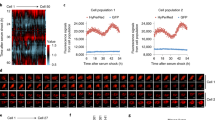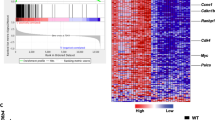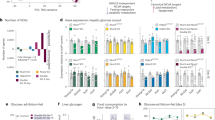Abstract
Mammalian metabolism is highly circadian and major hormonal circuits involving nuclear hormone receptors display interlinked diurnal cycling1,2. However, mechanisms that logically explain the coordination of nuclear hormone receptors and the clock are poorly understood. Here we show that two circadian co-regulators, cryptochromes 1 and 2, interact with the glucocorticoid receptor in a ligand-dependent fashion and globally alter the transcriptional response to glucocorticoids in mouse embryonic fibroblasts: cryptochrome deficiency vastly decreases gene repression and approximately doubles the number of dexamethasone-induced genes, suggesting that cryptochromes broadly oppose glucocorticoid receptor activation and promote repression. In mice, genetic loss of cryptochrome 1 and/or 2 results in glucose intolerance and constitutively high levels of circulating corticosterone, suggesting reduced suppression of the hypothalamic–pituitary–adrenal axis coupled with increased glucocorticoid transactivation in the liver. Genomically, cryptochromes 1 and 2 associate with a glucocorticoid response element in the phosphoenolpyruvate carboxykinase 1 promoter in a hormone-dependent manner, and dexamethasone-induced transcription of the phosphoenolpyruvate carboxykinase 1 gene was strikingly increased in cryptochrome-deficient livers. These results reveal a specific mechanism through which cryptochromes couple the activity of clock and receptor target genes to complex genomic circuits underpinning normal metabolic homeostasis.
This is a preview of subscription content, access via your institution
Access options
Subscribe to this journal
Receive 51 print issues and online access
$199.00 per year
only $3.90 per issue
Buy this article
- Purchase on Springer Link
- Instant access to full article PDF
Prices may be subject to local taxes which are calculated during checkout




Similar content being viewed by others
References
Yang, X. et al. Nuclear receptor expression links the circadian clock to metabolism. Cell 126, 801–810 (2006)
Green, C. B., Takahashi, J. S. & Bass, J. The meter of metabolism. Cell 134, 728–742 (2008)
Weinberger, C. et al. Identification of human glucocorticoid receptor complementary DNA clones by epitope selection. Science 228, 740–742 (1985)
Lonard, D. M. & O’Malley, B. W. The expanding cosmos of nuclear receptor coactivators. Cell 125, 411–414 (2006)
De Bosscher, K., Vanden Berghe, W. & Haegeman, G. Cross-talk between nuclear receptors and nuclear factor kappaB. Oncogene 25, 6868–6886 (2006)
Damiola, F. et al. Restricted feeding uncouples circadian oscillators in peripheral tissues from the central pacemaker in the suprachiasmatic nucleus. Genes Dev. 14, 2950–2961 (2000)
Lamia, K. A. et al. AMPK regulates the circadian clock by cryptochrome phosphorylation and degradation. Science 326, 437–440 (2009)
Asher, G. et al. SIRT1 regulates circadian clock gene expression through PER2 deacetylation. Cell 134, 317–328 (2008)
Asher, G. et al. Poly(ADP-ribose) polymerase 1 participates in the phase entrainment of circadian clocks to feeding. Cell 142, 943–953 (2010)
Lamia, K. A., Storch, K. F. & Weitz, C. J. Physiological significance of a peripheral tissue circadian clock. Proc. Natl Acad. Sci. USA 105, 15172–15177 (2008)
Marcheva, B. et al. Disruption of the clock components CLOCK and BMAL1 leads to hypoinsulinaemia and diabetes. Nature 466, 627–631 (2010)
Sadacca, L. A., Lamia, K. A., deLemos, A. S., Blum, B. & Weitz, C. J. An intrinsic circadian clock of the pancreas is required for normal insulin release and glucose homeostasis in mice. Diabetologia 54, 120–124 (2010)
Storch, K. F. et al. Extensive and divergent circadian gene expression in liver and heart. Nature 417, 78–83 (2002)
Panda, S. et al. Coordinated transcription of key pathways in the mouse by the circadian clock. Cell 109, 307–320 (2002)
Kornmann, B., Schaad, O., Bujard, H., Takahashi, J. S. & Schibler, U. System-driven and oscillator-dependent circadian transcription in mice with a conditionally active liver clock. PLoS Biol. 5, e34 (2007)
Schmutz, I., Ripperger, J. A., Baeriswyl-Aebischer, S. & Albrecht, U. The mammalian clock component PERIOD2 coordinates circadian output by interaction with nuclear receptors. Genes Dev. 24, 345–357 (2010)
Sato, T. K. et al. A functional genomics strategy reveals Rora as a component of the mammalian circadian clock. Neuron 43, 527–537 (2004)
Balsalobre, A. et al. Resetting of circadian time in peripheral tissues by glucocorticoid signaling. Science 289, 2344–2347 (2000)
Reichardt, H. M. et al. DNA binding of the glucocorticoid receptor is not essential for survival. Cell 93, 531–541 (1998)
Vollmers, C. et al. Time of feeding and the intrinsic circadian clock drive rhythms in hepatic gene expression. Proc. Natl Acad. Sci. USA 106, 21453–21458 (2009)
Zhang, E. E. et al. Cryptochrome mediates circadian regulation of cAMP signaling and hepatic gluconeogenesis. Nature Med. 16, 1152–1156 (2010)
So, A. Y.-L., Bernal, T. U., Pillsbury, M. L., Yamamoto, K. R. & Feldman, B. J. Glucocorticoid regulation of the circadian clock modulates glucose homeostasis. Proc. Natl Acad. Sci. USA 106, 17582–17587 (2009)
Doi, M. et al. Salt-sensitive hypertension in circadian clock-deficient Cry-null mice involves dysregulated adrenal Hsd3b6. Nature Med. 16, 67–74 (2010)
Barish, G. D. et al. A nuclear receptor atlas: macrophage activation. Mol. Endocrinol. 19, 2466–2477 (2005)
Lamia, K. A. et al. Increased insulin sensitivity and reduced adiposity in phosphatidylinositol 5-phosphate 4-kinase β mice. Mol. Cell. Biol. 24, 5080–5087 (2004)
Lavery, D. J. & Schibler, U. Circadian transcription of the cholesterol 7 alpha hydroxylase gene may involve the liver-enriched bZIP protein DBP. Genes Dev. 7, 1871–1884 (1993)
Nelson, J. D., Denisenko, O. & Bomsztyk, K. Protocol for the fast chromatin immunoprecipitation (ChIP) method. Nature Protocols 1, 179–185 (2006)
Stratmann, M., Stadler, F., Tamanini, F., van der Horst, G. T. & Ripperger, J. A. Flexible phase adjustment of circadian albumin D site-binding protein (DBP) gene expression by CRYPTOCHROME1. Genes Dev. 24, 1317–1328 (2010)
Thresher, R. J. et al. Role of mouse cryptochrome blue-light photoreceptor in circadian photoresponses. Science 282, 1490–1494 (1998)
Acknowledgements
We thank S. Kaufman for assistance with glucose tolerance tests, J. Alvarez for RNA sample preparation, H. Juguilon for luciferase assays, J. Vaughan for corticosterone and ACTH measurements, antigenic peptide design and peptide-KLH coupling reactions, H. Cho for sharing unpublished plasmids and R. Shaw for comments on the manuscript. This work was supported by National Institutes of Health grants DK057978 and DK062434 (to R.M.E.) and DK090188 (to K.A.L.), by support from the Glenn Foundation for Aging Research (to R.M.E. and K.A.L.), from the Helmsley Trust (to R.M.E.) and by a Merck fellowship from the Life Sciences Research Foundation (to K.A.L.).
Author information
Authors and Affiliations
Contributions
K.A.L. and R.E. conceived the project and designed the research. K.A.L., S.J.P., G.D.B. and N.H.U. performed the experiments. J.W.J. provided critical reagents. K.A.L. and R.T.Y. analysed the data. K.A.L. and R.M.E. wrote the paper. All authors edited the manuscript.
Corresponding authors
Ethics declarations
Competing interests
The authors declare no competing financial interests.
Supplementary information
Supplementary Figures
The file contains Supplementary Figures 1-7 with legends. (PDF 854 kb)
Rights and permissions
About this article
Cite this article
Lamia, K., Papp, S., Yu, R. et al. Cryptochromes mediate rhythmic repression of the glucocorticoid receptor. Nature 480, 552–556 (2011). https://doi.org/10.1038/nature10700
Received:
Accepted:
Published:
Issue Date:
DOI: https://doi.org/10.1038/nature10700
This article is cited by
-
The interaction between CRY1 Polymorphism and Alternative Healthy Eating Index (AHEI) on cardiovascular risk factors in overweight women and women with obesity: a cross-sectional study
BMC Endocrine Disorders (2023)
-
Circadian regulation of liver function: from molecular mechanisms to disease pathophysiology
Nature Reviews Gastroenterology & Hepatology (2023)
-
Inverse Relationship Between Clock Gene Expression and Inflammatory Markers in Ulcerative Colitis Patients Undergoing Remission
Digestive Diseases and Sciences (2023)
-
Transcriptional control of energy metabolism by nuclear receptors
Nature Reviews Molecular Cell Biology (2022)
-
Molecular regulations of circadian rhythm and implications for physiology and diseases
Signal Transduction and Targeted Therapy (2022)
Comments
By submitting a comment you agree to abide by our Terms and Community Guidelines. If you find something abusive or that does not comply with our terms or guidelines please flag it as inappropriate.



